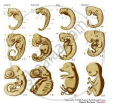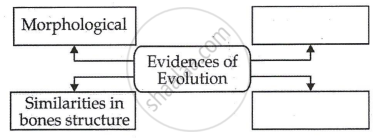Advertisements
Advertisements
प्रश्न
What do we call the degenerated or partially developed useless organs in living organisms? Enlist such organs in human body? How the same organs are useful in other animals?
उत्तर
- Degenerated or partially developed useless organs are called vestigial organs.
- Wisdom tooth, Appendix, Body hairs, Coccyx, are some vestigial organs in human body.
- Coccyx supports the tail in other animals. Body hairs protect from cold.
APPEARS IN
संबंधित प्रश्न
Mammals : _________ : : Amphibia : Fishes
Differentiate between homology and analogy. Give one example of each.
Which of the following pairs of two vegetables represent the correct homologous structures?
(A) Sweet potato and potato
(B) Sweet potato and tomato
(C) Carrot and potato
(D) Radish and carrot
Differentiate between analogy and homology giving one example each of plant and animal respectively.
Four students A, B, C and D reported the following set of organs to be homologous. Who is correct ?
(A) Wings of a bat and a butterfly
(B) Wings of a pigeon and a bat
(C) Wings of a pigeon and a butterfly
(D) Forelimbs of cow, a duck and a lizard
Attempt giving a clear definition of the term species.
Give the importance of fossil in support of organic evolution
Name the scientists who Discovered the fossil of Australopithecus
How do homologous organs help in providing evidence for organic evolution?
Differentiate between analogous and homologous structures.
The organs which perform different functions but have the same basic structure are known as :
(a) homologous organs
(b) analogous organs
(c) homolytic organs
(d) analytic organs
The wings of a housefly and the wings of a sparrow are an example of :
(a) analogous organs
(b) vestigial organs
(c) respiratory organs
(d) homologous organs
X, Y, and Z are three animals. The animal X can fly but animal Y can only run on ground or walls. The forelimbs of animals X and Y have the same basic design but they are used for different purposes such as flying and running respectively. The animal Z became extinct an long time ago. The study of fossils of Z tells us that it had some features like those of X and some like those of Y. In fact, Z is said to form a connecting link in the evolutionary chain of X and Y.
(a) What could the animals X, Y and Z be?
(b) What name is given to the forelimbs like those of X and Y which have the same basic design but different functions?
(c) Name one feature in which Z resembled X.
(d) Name one feature in which Z resembled Y.
(e) Which is the correct evolutionary chain involving X, Y and Z : X → Z → Y or Y → Z → X?
In a class, students were asked to observe the models/slides/pictures of the skeletons of forelimbs and wings of different organisms. After the observations the students made the following groups of homologous structures. Select the correct group :
(A) Wings of a bird and a butterfly
(B) Wings of a pigeon and a bat
(C) Wings of a butterfly and a bat
(D) Forelimbs of a cow, a duck and a lizard
You have potato, carrot, radish, sweet potato, tomato and ginger bought from the market in your jute bag. Identify two vegetables to represent the correct homologous structures.
(A) Potato and tomato
(B) Carrot and tomato
(C) Potato and sweet potato
(D) Carrot and radish
Observe the picture and answer the following questions.
A) Which evidence of evolution is shown in the picture?
B) What can be proven with this proof?
C) Give one more example of evidence of evolution
Draw a labelled diagram of T.S. of a leaf showing Kranz anatomy.
Explain any three molecular (genetic) evidences in favour of organic evolution.
Give scientific reason.
Duck-billed platypus shows relationship with mammals.
Write a short note:
Embryological evidences
Define the evidence of evolution shown in the figure.

Explain any five types of evidence that support the theory of evolution.
Homologous organs and vestigial organs are examples of ______ type of evidence in evolution.
Select the CORRECT match.
Study of fossils is ______.
The process of mating of individuals, which are more closing related than the average of the population to which they belong is called ______.
Animal husbandry and plant breeding programmes are the examples of ______.
Appearance of antibiotic-resistant bacteria is an example of ______.
Fossils are generally found in ______.
What are we referring to? When we say 'simple organisms' or 'complex organisms'.
While creation and presence of variation is directionless, natural selection is directional as it is in the context of adaptation. Comment.
Find odd one out:
Evolutionary convergence is the development of a ______.
Write a note on the significance of Palaeontology.
Industrial melanism was highlighted by ______.
Industrial melanism in England after 1850 is an excellent example of Natural selection. Explain how?
Complete the following conceptual picture:

